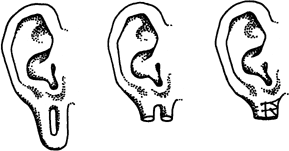Earlobe Reconstruction History
Because earlobe stretching is one of humanity's oldest body modifications, earlobe reconstruction surgery is one of its oldest forms of plastic surgery. Because large earlobes are essentially permanent (they rarely go back to "normal" if stretched too far), at any point in history where people with stretched lobes live with those without, there are people who regret their decisions and want to move from one group to another. Hence the need for a surgery that "corrects" ears from stretched to unstretched.
In India somewhere around 300 BC, a surgeon called Sushruta described a procedure for restoring stretched lobes that had been torn off — in India at the time earlobes had both spiritual/cultural and esthetic value and long ones were highly desirable, so if one was damaged there was a need to fix it. Sushruta's "fix" for this became the basis for pedical flap surgery which is still used today. In his text Sushruta Samhita he writes,
A surgeon well versed in the knowledge of surgery should slice off a patch of living flesh from the cheek of a person devoid of earlobes in a manner so as to have one of its ends attached to (the cheek). Then the part where the artificial earlobe is to be made should be slightly scarified and the living flesh ... should be stuck to it.
Pretty impressive for well over two thousand years ago! Some writers have suggested that it is India's experimentation with body modification that lead them to develop medical technologies that wouldn't become common in the West for millennia later.
In later times, the Romans went the other direction. In the 1st century AD the writer Celcus describes in his medical encyclopedia a procedure to convert stretched ears back into normal lobes. As you can see from the illustration below, it's an almost identical procedure to the ones doctors use in modern times:
In more recent history, plastic surgery has been used to Westernize "savages" who wish to transition from Africa, South America, and other regions where stretching is still the norm, as well as to correct the mistakes of individuals who stretched farther than they turned out to be able to handle in their life.
(Reference: "Ancient Inventions" by Peter James and Nick Thorpe)
